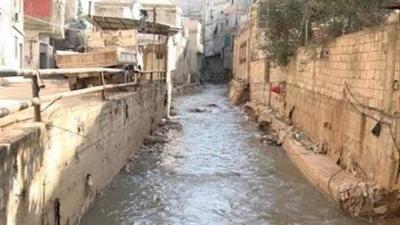Last Saturday, work began to expand and deepen the Al-Ghadeer River by contractors from the Ministry of Public Works. Minister Ali Hamiyeh stated on Twitter that this project "has not been implemented for more than twenty years... in an attempt to solve the chronic problem of its flooding." This announcement was welcomed by Hamiyeh's followers on Twitter, but it also faced criticism calling for fundamental solutions, starting with the removal of waste and limiting its dumping in the river, to addressing the issues of illegal and random construction. Residents of the area, who welcome any steps to protect them from the annual floods they have grown accustomed to, and currently from cholera threats, share similar demands: they seek comprehensive solutions, not temporary fixes.
For many years, the Al-Ghadeer River has turned into an open sewer, carrying mixtures of chemical and organic toxins, both liquid and solid, to the sea. At the mouth, there is a dysfunctional treatment station, overwhelmed by whatever the river has carried from the highlands passing through various areas along its route.
Our tour began from the train track. Yes, there used to be a track in the Salim neighborhood over which a train passed, with a clear river running beneath it, surrounded by olive, mulberry, and pine trees, as mentioned by Hajjah Harba Wahba, a resident of Hermel who has lived by the river since she was a child. The area has transformed before her eyes from a place resembling a painter's canvas to a location filled with all the unpleasant odors and mosquito bites, "even the gnats here are different; a bite causes swelling and poisons the body, leaving a mark." The arrival of winter is somewhat comforting for Wahba, as "the state and municipality remember that there are humans living here, so they begin cleaning the riverbed and reducing the tons of waste that accumulate throughout the summer, turning the river into a public landfill and a stagnant body of refuse and sewage that suffocates residents. Just imagine all these odors with summer carcasses and no electricity; we were dying."
The neighbors of the river describe their hellish existence beside it, a situation made worse by the economic collapse. When we ask Abu Ali about his fear of cholera, he replies, alongside his coughing grandson, "Cholera is already here." People live amid rodents, bug infestations, and stray dogs and cats that find the river a perfect breeding ground. "We spent a black summer without electricity and regulated generators barely functioning."
Abu Ali reflects on 1972, when he moved from Hermel to the river and built a small house, noting that at that time, there was only the Lebanese University, orchards, and the train track. "In front of the university gate, there flowed a river that dumped at what is now known as Station 4, then meandered towards the Salim neighborhood. The area was once filled with springs and streams, all of which have been filled in, replaced by illegal buildings." He points out that "the Lilaki stream is still visible today. Who would believe that a river we once swam in would turn into this misery within 50 years.... and a dumping ground."
The neighborhood took its current form during the civil war, with waves of displacement to the cities from the south due to the Israeli occupation and from the Beqaa in search of work opportunities. Homes were hastily built, stabilized over time, and most became concrete structures. We enter Abu Ali's windowless dark home, which lacks electricity and sunlight, to see the scene after the Ministry of Public Works recently cleaned the river. "It hasn’t even been two days since they cleaned it, and it’s starting to fill with waste again. People throw all their garbage out of the windows." Residents on both banks turn their backs on the river. No balconies overlook the river; instead, there are concrete supports and walls to protect against flooding and to block insets and overpowering odors.
"We are not used to the smell of the river; the odor is unbearable," says Hussein, a university student who works at a van service. The problem, in his view, is the lack of infrastructure that forces the river's neighbors to dispose of their waste in it. "The roads are narrow; they are essentially alleyways, while the municipality comes every two weeks to collect the waste that accumulates under the bridge, spreading and flying around due to cars, wind, passersby, and scavengers, making it easier for people to just throw it in the river, which drains into the sea."
Hussein explains, "If it were just about the waste, it would be simple. Here, you can clearly see sewage pipes extending from homes pouring their black water into the river, while industrial and slaughterhouse waste flows down from the higher areas." He confirms that the problem worsens as one moves down toward the sea. "The people living closer to the beach, near the station, have everything dumped at their place, and the household waste and odors are stronger there due to the station’s failure."
Neighbors of the Al-Ghadeer River on Martyr Street, east of the university, are mostly Syrians renting homes from Lebanese owners. They, too, lament the tragedies of life alongside the river. Hannah, a mother of two who has lived there for six years, says that "in addition to the odors and diseases, the rent here is steep. Two and a half million [LBP], and prices are high for everything; even the water we have to buy." Here, you see children playing by the toxic pools, swimming and tossing stones near bags of trash, while stagnant water flows from the pipes extending from their housing units directly into the river.
Haja Hayat Ammar, who comes from Baalbek, tells us, "You will get the same responses from everyone here; the smell alone summarizes all the answers; how is life here? It’s war; we are in a war with the river."




